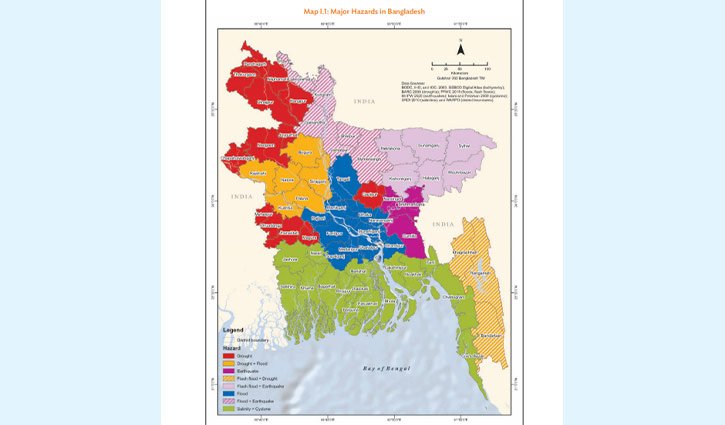The Asian Development Bank (ADB) has hailed Bangladesh for its measures to tackle the climate change issues and protect the vulnerable communities.
The ADB made the observation in a publication titled ‘Bangladesh Climate and Disaster Risk Atlas’. Together with the Planning Commission of Bangladesh, the ADB launched the Atlas at a virtual meeting on Thursday.
“The country has created a Bangladesh Climate Change Trust Fund with its own financial resources – a first among least developed countries,” said the ADB.
According to the publication, relevant ministries and divisions of Bangladesh have, in the last 7 fiscal years, undertaken 440 projects with this fund. Also, the ministry of environment, forest, and climate change is currently leading the preparation of the National Adaptation Plan (NAP) as a commitment for long-term adaptation investment to identify country-specific adaptation needs and develop and implement strategies to address these needs, especially to protect vulnerable communities.
Bangladesh is a member of the 48-nation Climate Vulnerable Forum and assumed its presidency for a second tenure in June 2020.
The ADB said the gross domestic product of Bangladesh grew steadily during the last decade and rose to 8.2 percent in 2019, indicating stable progress in local production and economic growth.
“At the same time, the country is placing significant importance and emphasis on the environment and climate change issues,” said the ADB.
The ADB also said Bangladesh is committed to ensuring climate change preparedness by producing the National Adaptation Programme of Action (NAPA) in 2005 and the Bangladesh Climate Change Strategy and Action Plan (BCCSAP) in 2009. The BCCSAP presents six pillars for climate actions, across which a total of 44 programmes were identified for relevant interventions.
Many other policy documents, such as those in the agriculture and health sectors, also address climate change, albeit in a skeletal form. Bangladesh has also implemented many of the projects recommended in its NAPA and BCCSAP, said the Manila-based international development partner.
However, the ADB said due to climate change, Bangladesh has been experiencing increased temperatures, erratic rainfall patterns, sea level rise, and salinity intrusion at an accelerated rate, causing more intense disasters.
Planning Minister Muhammad Abdul Mannan, State Minister for Planning Shamsul Alam, ADB’s Vice President (Operations 1) Shixin Chen, Director General for ADB’s South Asia Department Kenichi Yokoyama, Secretary, Ministry of Disaster Management and Relief Md. Kamrul Hasan ndc, Deputy Director General for ADB’s South Asia Department Manmohan Parkash, ADB Country Director for Bangladesh Edimon Ginting and Liping Zheng, advisor, Office of the Director General for ADB’s South Asia Department, among others, attended the event.
About this Atlas:
This risk atlas was prepared to help further understand the variability of climate-induced hazards and associated disaster risks in Bangladesh, specifically in the agriculture and water sectors.
It shows thematic maps in Hazards—Volume I and Exposures, Vulnerabilities, and Risks—Volume II. Hazards are climate, geophysical, ecological, and anthropogenic events that cause losses and damages; exposures are those elements affected by hazards; associated vulnerabilities are multidimensional in that these constitute physical susceptibilities and sensitivities as well as lack of coping (short term) and adaptive capacities (long term). The spatial unit of the maps is district level, with data sources mostly secondary. A wide variety of data (e.g., water level, precipitation, wind speed, population, education, income, crop, forest, settlement, poverty, education, etc.) including geospatial and other forms were collected, corrected, and processed using GIS.
Who can use the Atlas?
This was prepared for concerned stakeholders with current or planned development activities in Bangladesh, including public and private sectors, non-government organizations, research and academic community, development partner agencies, other financial institutions, and the public. It will also be a useful reference for other developing countries with geographic and environment conditions similar to Bangladesh.

